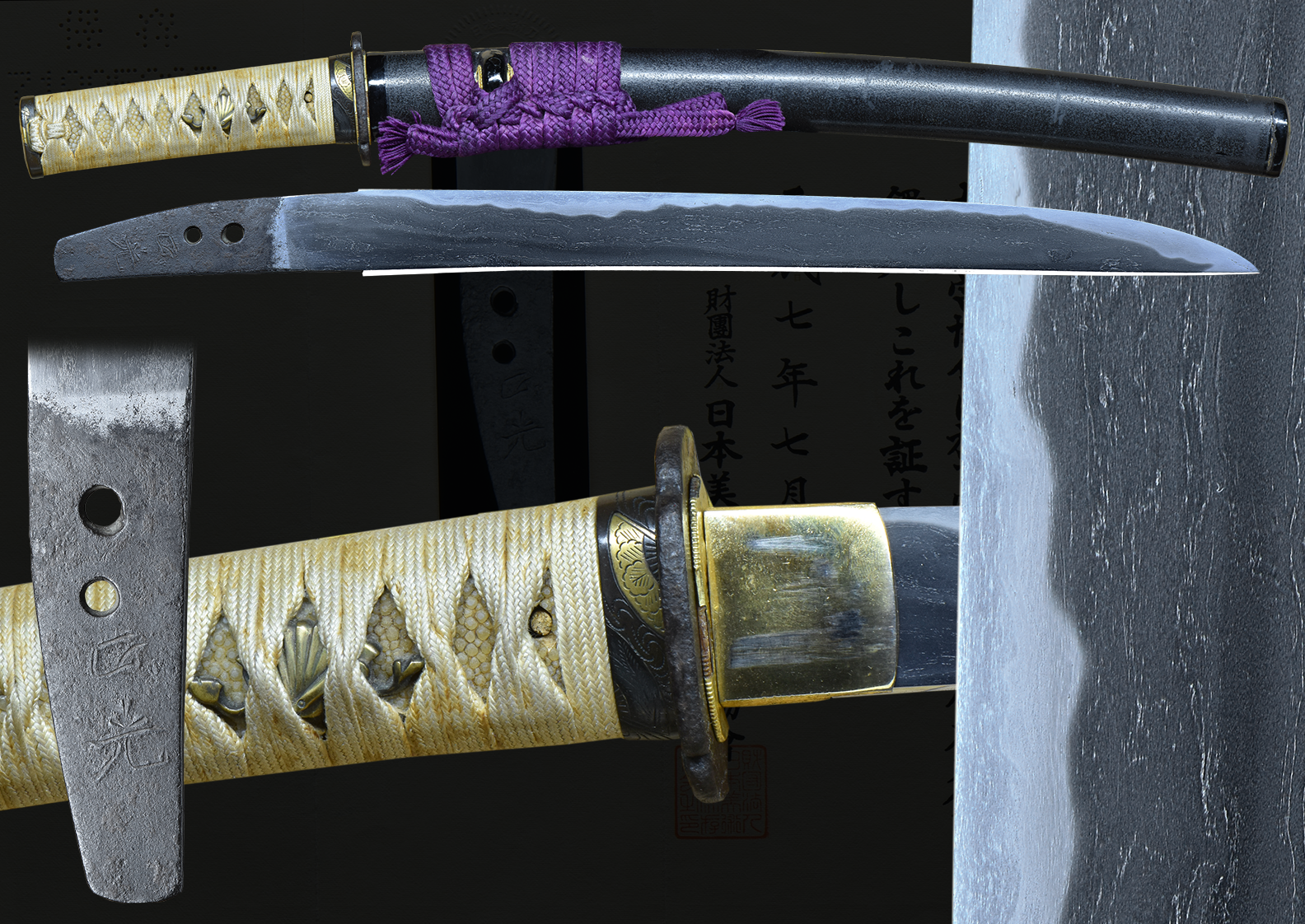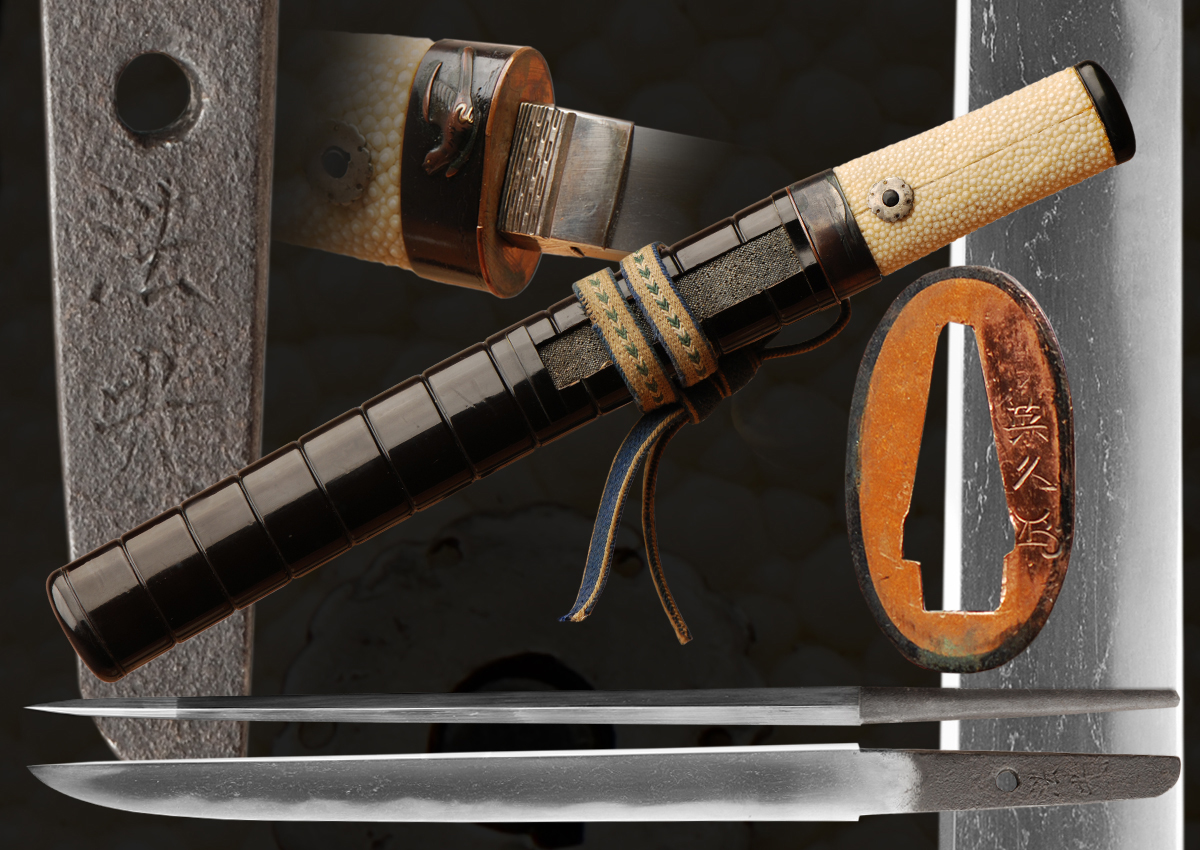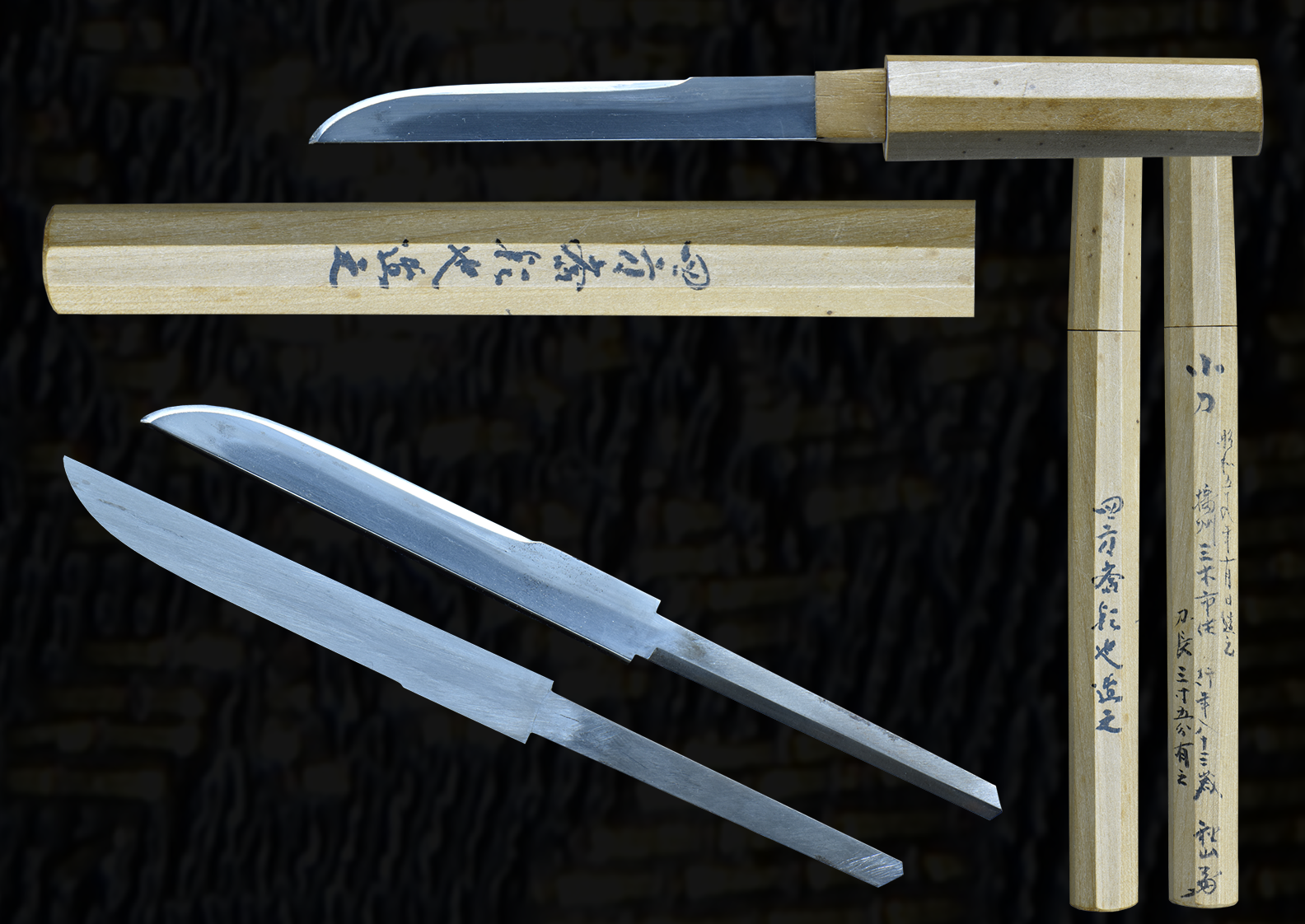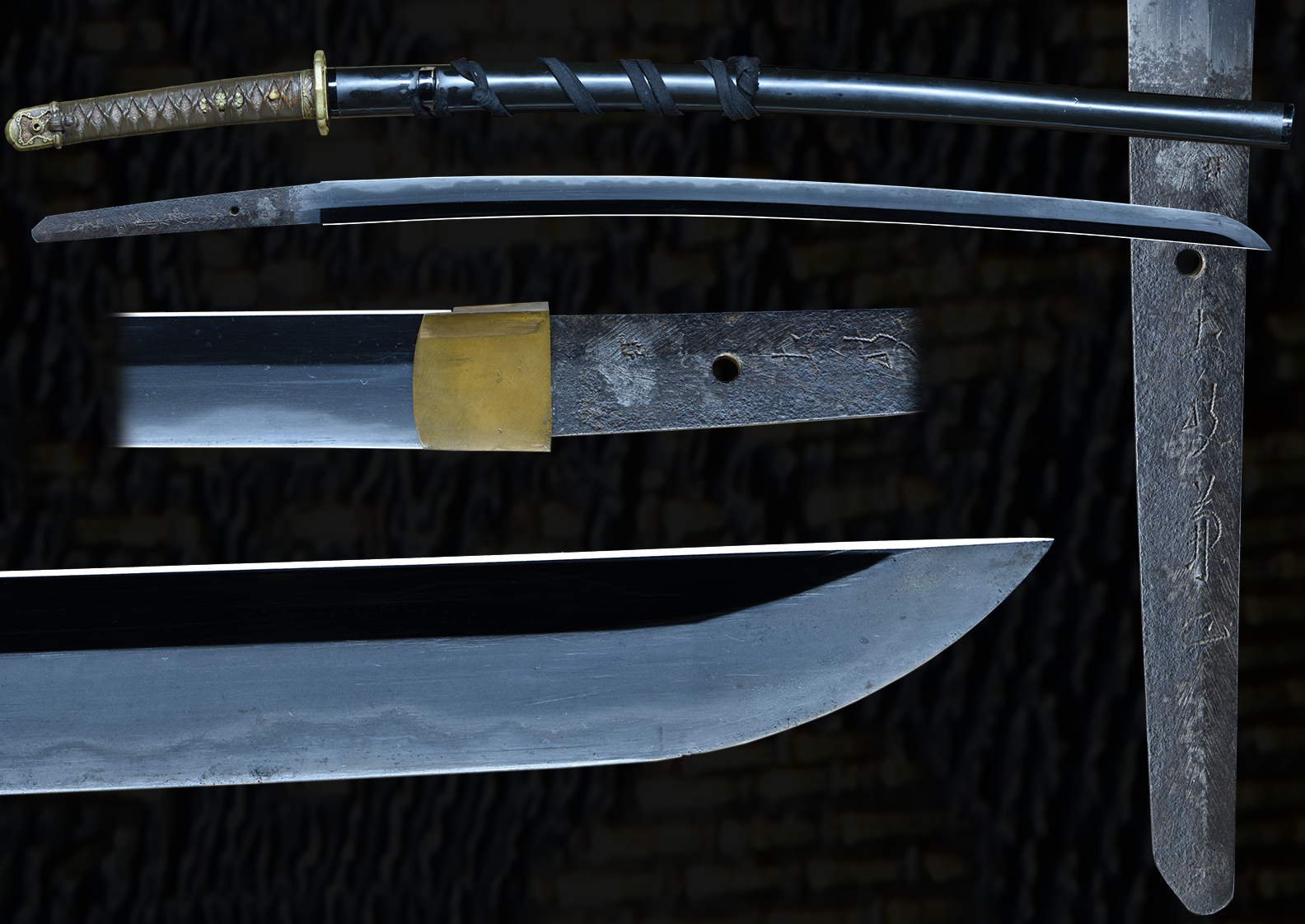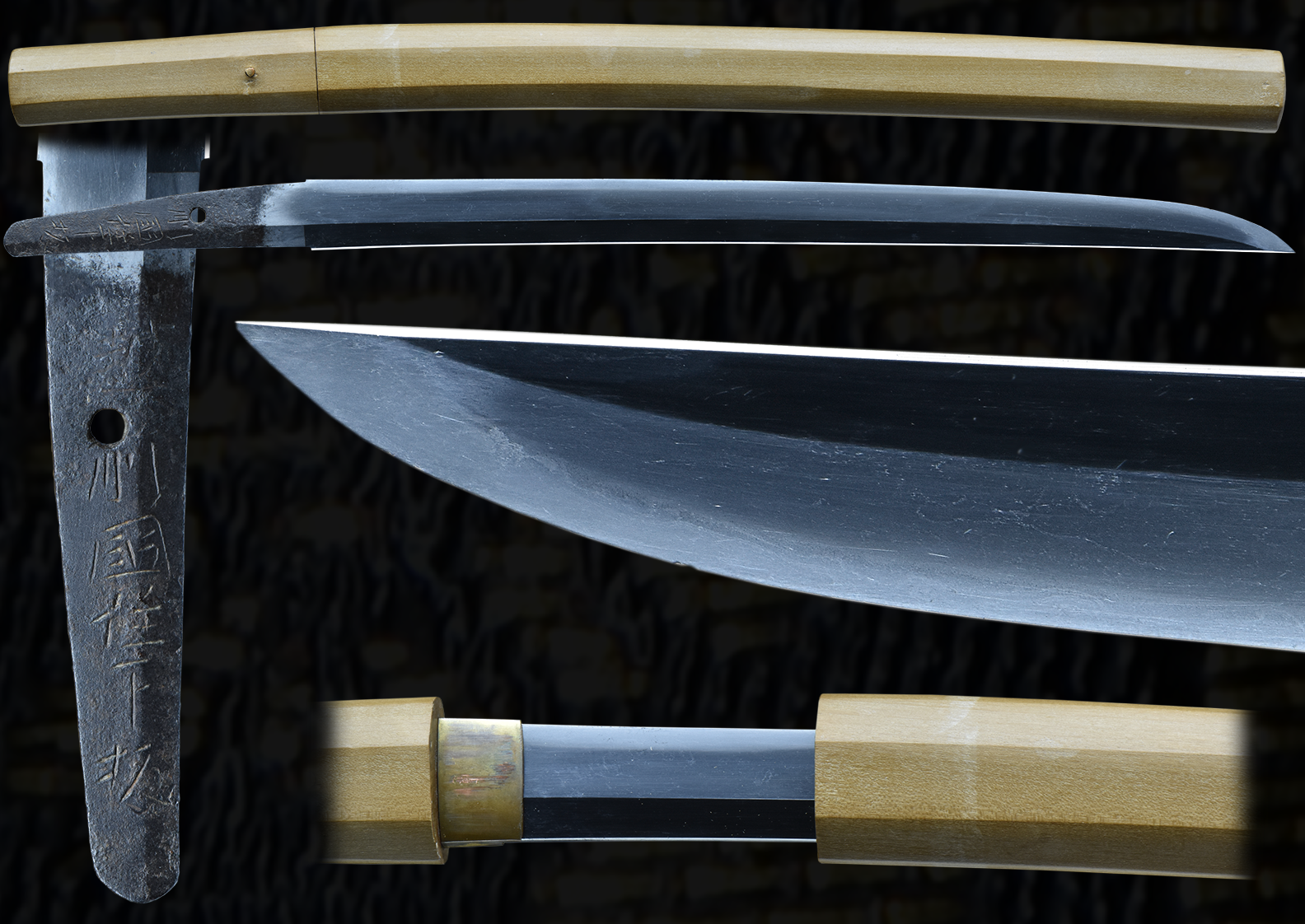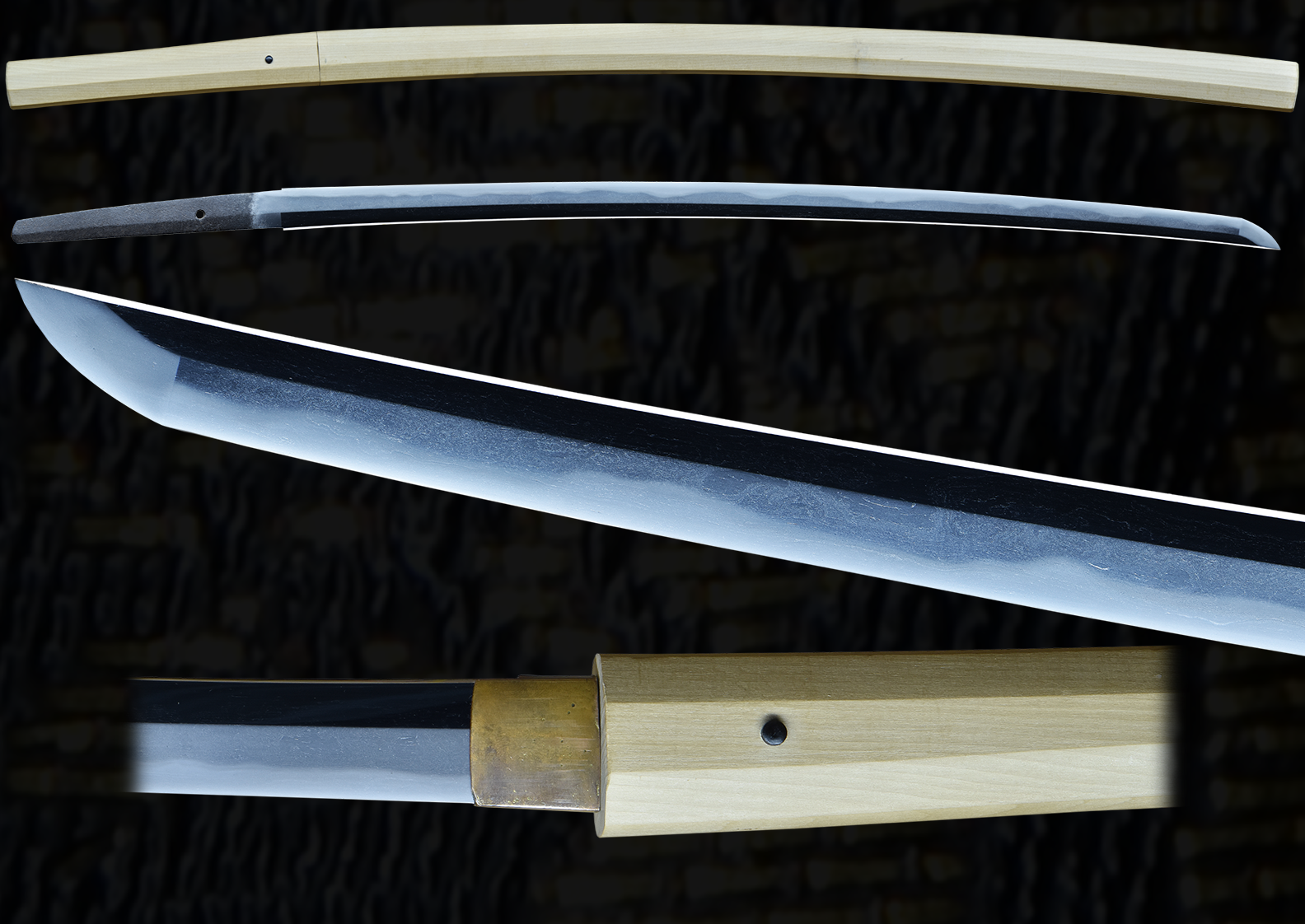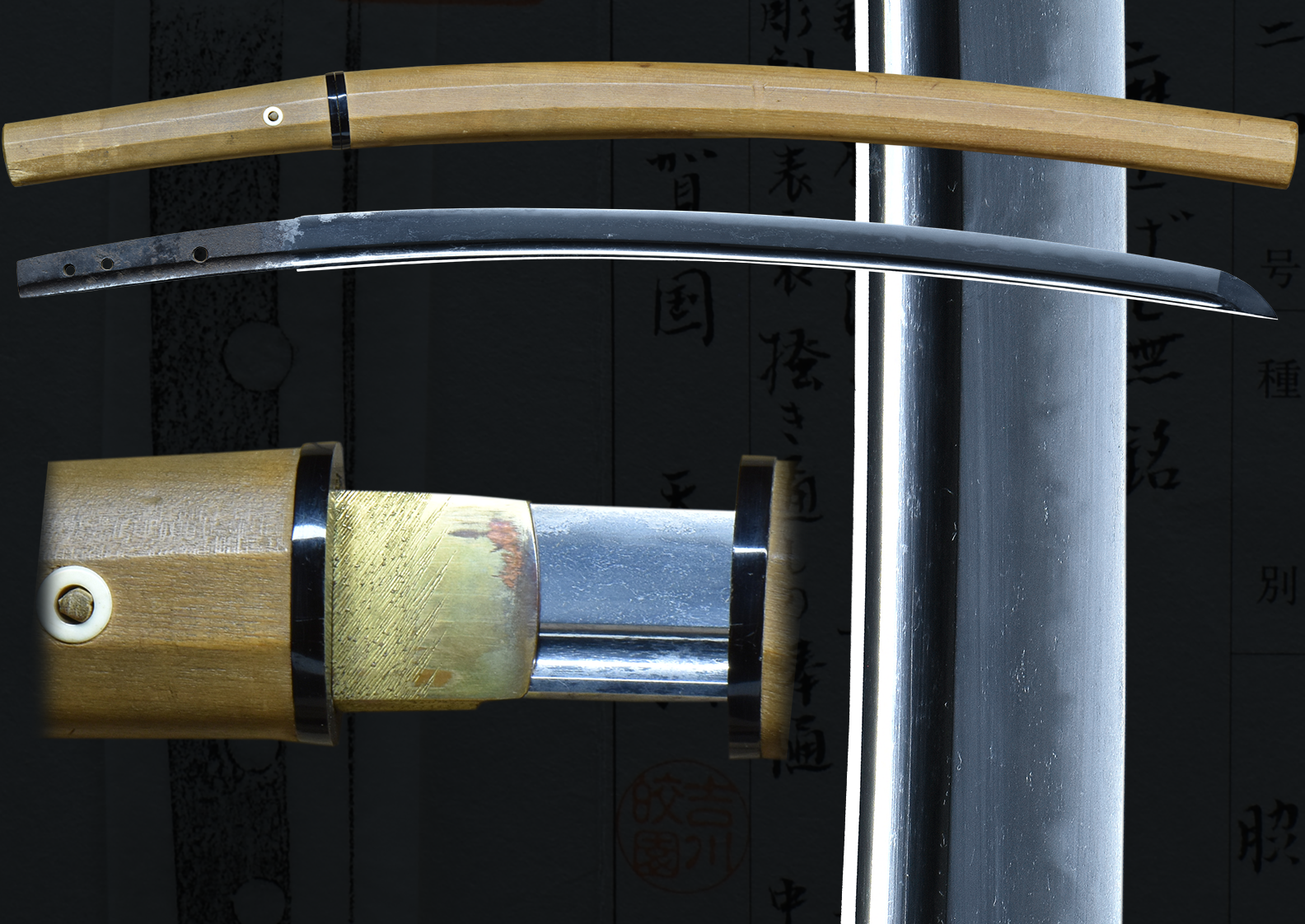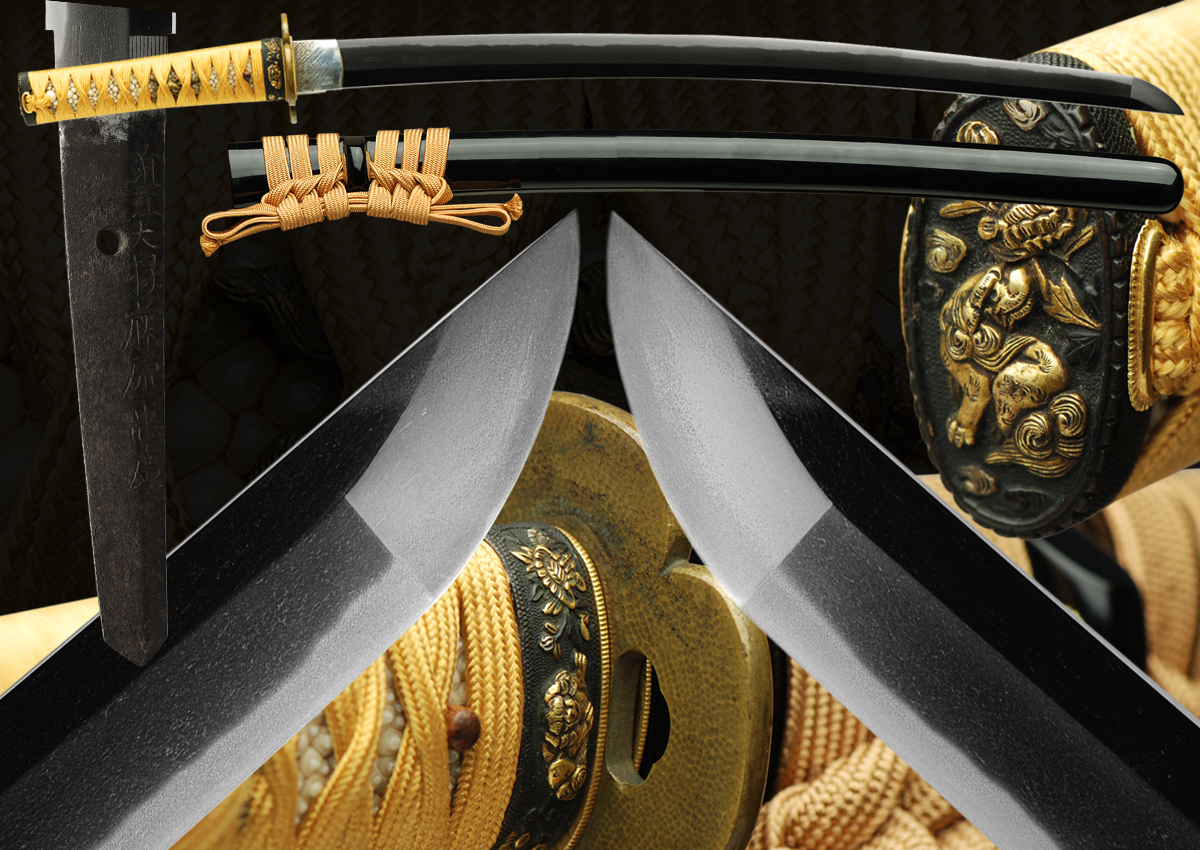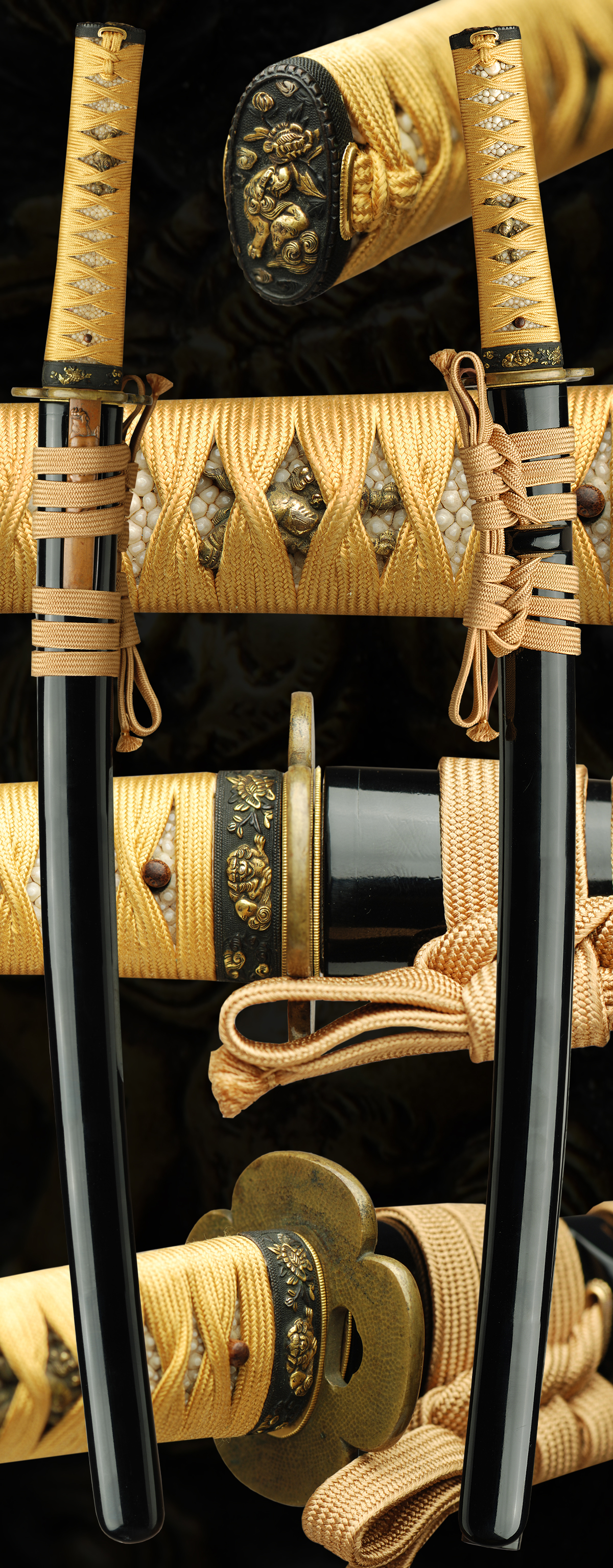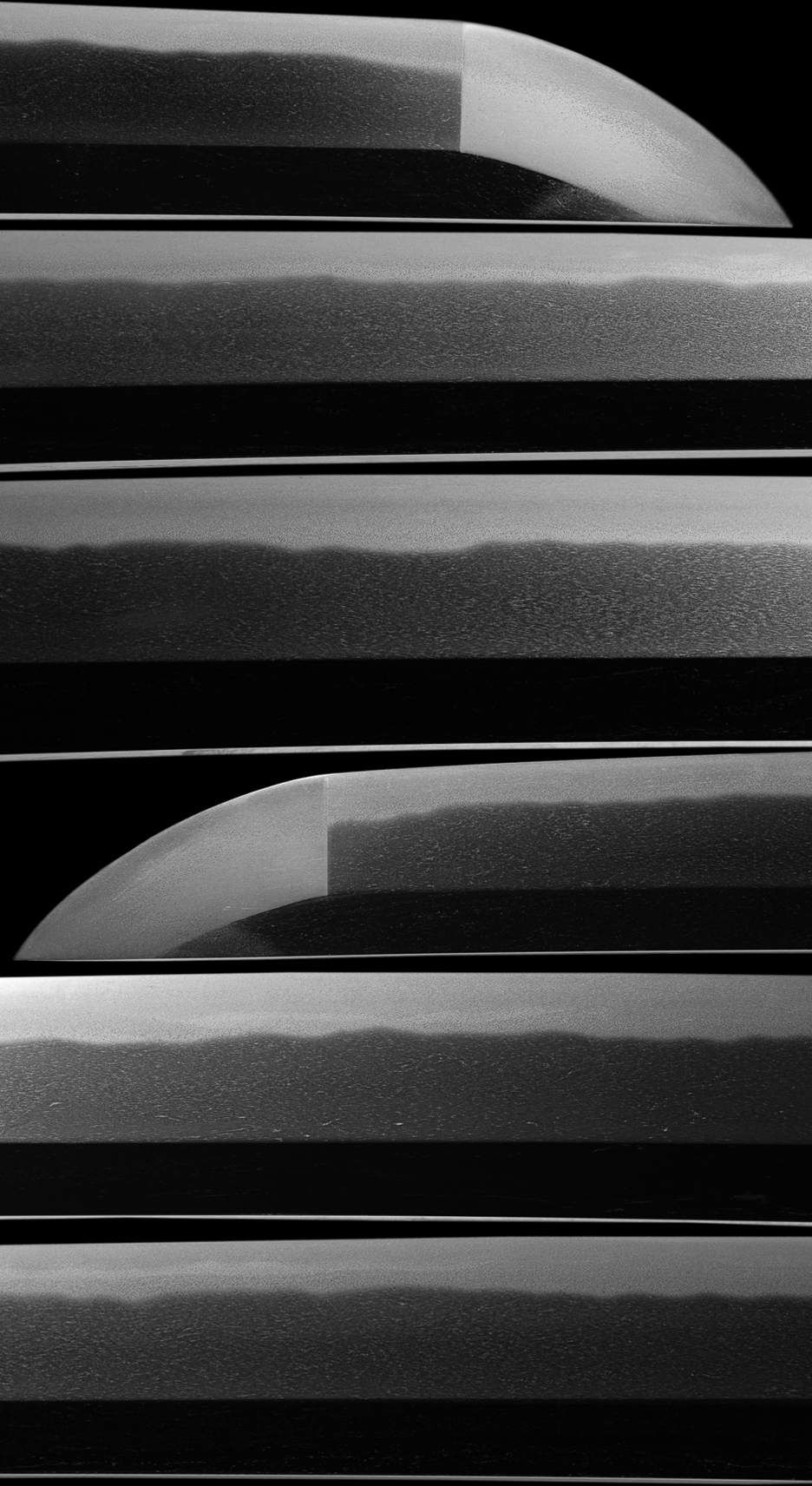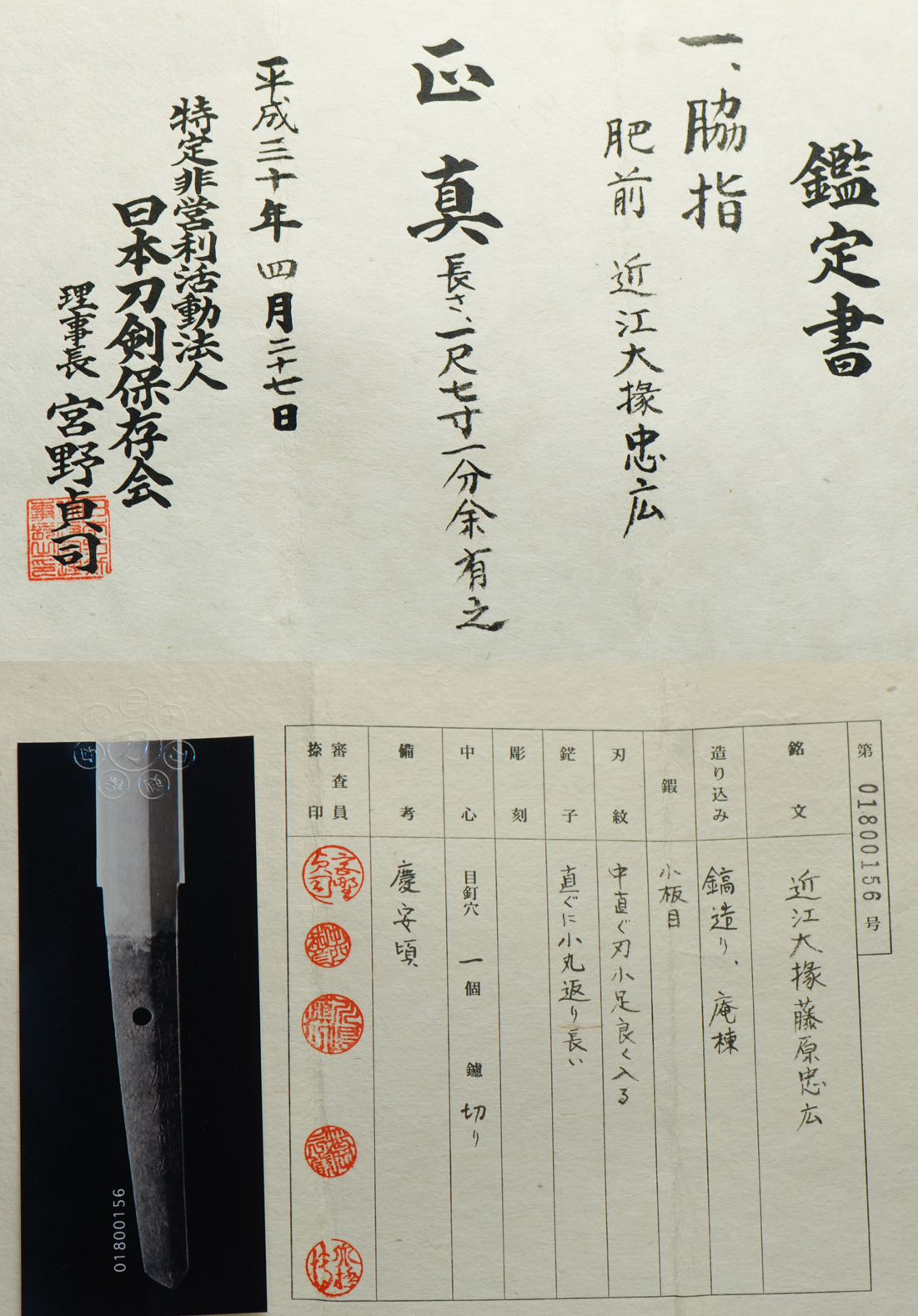A beautiful sword in the Hizen tradition. This blade is a wonderful example of one of the best smiths of the Tadayoshi line. This sword is signed “Omi Daijo Fujiwara Tadahiro” and the shinsa team dated it Keian 1648. That would be the 2nd generation and in Fujishiro he is listed as “Jo Jo Saku level”.
Fujishiro ratings:
Saijo saku (High level Very best smith)
Jojo saku (High level best smith)
Jo saku (High level smith)
Chujo saku (Good level smith)
Chu saku (standard level smith)
(please note this is a general interpretation of the Fujishiro ratings)
This Tadahiro is in immaculate fully restored condition, papered and mounted. This sword comes ensuite with Shishi motif. The Fuchi/Kasira and menuki are of Shishi dogs. There is a signed Shishi kodzuka in copper finish and is signed. The habaki is completed in silver foil. The sageo and ito are of a gold color. The saya has a very nice gloss black lacquered finish. An age old patina on a wonderful Same (rayskin) that adorns the tsuka. A great package for all collectors.
Shishi (or Jishi) is translated as “lion” but it can also refer to a deer or dog with magical properties and the power to repel evil spirits. A pair of shishi traditionally stand guard outside the gates of Japanese Shinto shrines and Buddhist temples, although temples are more often guarded by two Nio protectors. The Shishi (like the Nio) are traditionally depicted in pairs, one with mouth open and one with mouth shut. The opened/closed mouth relates to Ah (open mouth) and Un (closed mouth). “Ah” is the first sound in the Japanese alphabet, while “N” (pronounced “un”) is the last. These two sounds symbolize beginning and end, birth and death, and all possible outcomes (from alpha to omega) in the cosmic dance of existence. The first letter in Sanskrit is “Ah” as well, but the last is “Ha.” Nonetheless, the first and last sounds produced by the mouth are “Ah” and “M.” The Sanskrit “m” and the Japanese “n” sound exactly the same when hummed with mouth closed. The spiritual Sanskrit terms AHAM and AUM thus encapsulate the first letter-sound (mouth open) and the final sound (mouth closed). Others say the open mouth is to scare off demons, and the closed mouth to shelter and keep in the good spirits. The circular object often shown beneath their feet is the Tama 玉, or sacred Buddhist jewel, a symbol of Buddhist wisdom that brings light to darkness and holds the power to grant wishes.
- Mei: Omi Daijo Fujiwara Tadahiro
- Date: Keian (1648)
- Nagasa: 20-1/2 inches
- Sori: 12.0 mm
- Width at the ha-machi: 30.1 mm
- Width at the yokote: 21.0 mm
- Thickness at the mune-machi: 6.52 mm
- Construction: Shinogi zukuri
- Mune: Iori
- Nakago: Ubu
- Kitae: Itame with nishijihada
- Hamon: Midare
- Boshi: Maru
- Condition: Good polish
(shipping and insurance included)
Email us if your interested in this item and remember to include the order number for this item: fss-804.
Click to Enlarge Image
Click to Enlarge Image
Click to Enlarge Image
” The Hizen school is one of the most famous and recognized by collectors of all levels.”
Hashimoto Shinzaemon was born in 1572 to a samurai family. His father and grandfather were both killed early on, and being orphaned at the age of 13 he took up sword smithing with relatives (possibly Iyo no Jo Munetsugu) at Nagasemura. He took up the name Tadayoshi, and his skill must have grown rapidly, for at the age of 25 he travelled to Kyoto and was accepted as a student of Umetada Myoju. Myoju was fond of performing horimono for Tadayoshi’s blades, and this illustrates a close bond and no doubt a respect on the part of the teacher for the imposing potential of his top student and these two are often counted among the top five smiths of the entire Shinto period.
Tadayoshi would eventually leave Kyoto to work for the Nabeshima clan in Hizen province. The Nabeshima specifically fostered the school set up by Tadayoshi and Hizen became a great swordmaking center, and no doubt brought much revenue back to the Nambeshima daimyo. Late in his life Tadayoshi received the title of Mutsu no Daijo, and on this occasion he changed his name to Tadahiro and his style changed along with his signature. In 1614 he became father to Hashimoto Heisakuro, who would join his father’s forge at the young age of 10 and eventually take on his personal name Shinzaemonnojo, and then his father’s art name of Tadahiro After Shodai Tadayoshi died in 1632, his young son at the age of 19 was left in charge of the shop and the many students of the late master. During these first few years he received much assistance and instruction from the Shodai Masahiro and Yoshinobu. In 1641 at the age of 28, the nidai Tadahiro received the title Omi no Daijo, and today just the simple reference of Omi Daijo is used to indicate him in discussions between enthusiasts. His skill was very high (Jo-jo saku), though only on few occasions did he challenge his father (Sai-jo saku) in the art of swordsmithing. Possibly if his father had lived longer to teach his son more, then Omi Daijo might have surpassed him on all counts. As it was, Omi Daijo lived for 81 years so put his signatures into blades for a very healthy 60 year timeframe. He would train his own son into the family profession and see him restore the Tadayoshi name as Mutsu no Kami Tadayoshi. Under the tutelage of Omi Daijo, Mutsu no Kami would even surpass the great works of the Shodai Tadayoshi. Omi Daijo died in 1693, having built the Hizen school into a great manufacturing center for swords and satisfying a great demand throughout Japan for their work. In fact, demand for Omi Daijo blades reached such a peak that students of the Shodai Tadayoshi (Masahiro and Yoshinobu) as well as his son Mutsu no Kami created daisaku under his name to address the demand. He is perhaps the most prolific smith of the Shinto period, with a work span of over 60 years and he would also outlive his own son, the third generation of the line, Mutsu no Kami Tadayoshi. Tadahiro died at the age of 80 on May 28 of 1693 and he is ranked at Jo-jo saku by Fujishiro for extremely superior work, 800 man yen (very highly regarded) by Dr. Tokuno and O-wazamono for blades of formidable cutting ability.
His style is typical for the Hizen Tadayoshi line: a strong sugata and a kitae and hamon that borrowed elements of the Rai School, mostly Rai Kunimitsu. Like Rai, the skin steel was forged very thin on Hizen swords so it is common to see shingane showing through. The jigane is usually a fine quality itame, sometimes nishijihada (pear skin hada) based on the works of the Rai smiths. The typical suguba hamon is done in nie deki, though there are departures into choji midare (and other smiths of the Hizen school like Masahiro do specialize in these more florid styles). It was an old rule that swords with a sharp nakagojiri were works of Omi Daijo and if the point was not so strong then it was daisaku by his students. The current thinking states that the strongly pointed ones are early work of Omi Daijo, and lacking this it is the template for work in later life (so either a late work of Omi Daijo or else daisaku). Since the founding of the school, the Nabeshima Daimyo who controlled Saga in Hizen made a point of sponsoring the work of the Tadayoshi line of smiths and encouraging an export market for their work. The business acumen of the Nabeshima combined with the excellent quality of the swords from the Tadayoshi school made them a dominant school in Japan through the nine generations of the main line. The smiths of this school are known for their ability to work in multiple styles based on great koto works. This has its root in the teachings of Umetada Myoju, the teacher of Shodai Tadayoshi and from whom Tadayoshi received part of his name. Umetada Myoju was an expert in the Soshu den and the early Mino den of Shizu Kaneuji, and Tadayoshi both learned and mastered the necessary techniques for this style of production. The style synonymous with his own lineage though is based on the Rai style of Yamashiro, and in particular the work of Rai Kunimitsu is the main template for their work. Older Yamashiro work by smiths like Niji Kunitoshi and Rai Kuniyuki uses a flamboyant choji which was in imitation of the Ichimonji smiths working at the same time in the Kamakura period. This style is also adopted into the Tadayoshi school but the violent midareba is usually more commonly found in associated smiths off the main line.
For Sale
